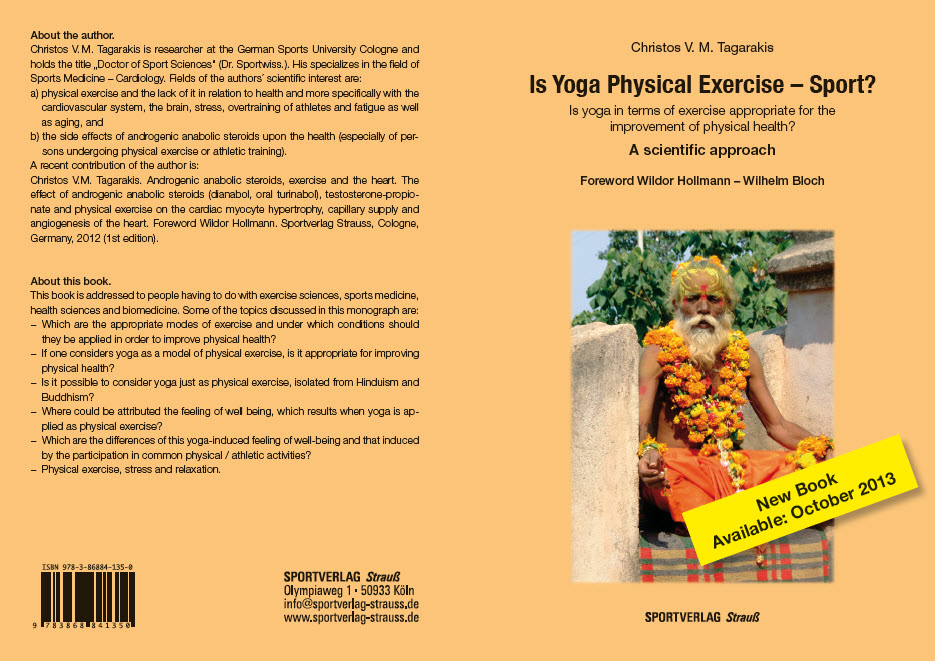Γιόγκα Νέο Βιβλίο-Yoga NEW Book
19 Σεπτεμβρίου 2013
Available: October 2013
Is yoga physical exercise – sport?
Is yoga in terms of exercise appropriate for the improvement of physical health?
A scientific approach
Christos V.M. Tagarakis
Foreword Wildor Hollmann – Wilhelm Bloch
Sportverlag Strauß,
Cologne, Germany, 2013
ISBN 978-3-86884-135-0
In Greek (Στα Ελληνικά):
Edition 2010
Είναι η γιόγκα σωματική άσκηση – γυμναστική; Χρήστος Ταγαράκης, Εκδόσεις Διάλογος, Αθήνα 2010. (Is yoga physical exercise – sports? Christos Tagarakis. Dialogos Publications, Athens, Greece 2010). Source in Internet: http://www.ppu.gr/greek/book_gr2.htm
Edition 2013 (in press – υπό έκδοση):
Είναι η γιόγκα σωματική άσκηση – γυμναστική; Μια επιστημονική προσέγγιση. Δρ. Χρήστος Ταγαράκης, Εκδόσεις Διάλογος, Αθήνα 2013.
In internet (in Greek) – Στο διαδίκτυο:
Είναι η γιόγκα σωματική άσκηση (γυμναστική);
Περισσότερα: http://www.antibaro.gr/article/611, Ἀντίβαρο
(source: http://www.antibaro.gr/index.php?option=com_content&task=view&id=5506&Itemid=88 ) on 29.08.2009.
Contents
| 1. Introduction: Yoga and physical exercise. |
|
| 2. Various aspects of the topic. |
|
| 2.1. Which are the appropriate modes of exercise and under which conditions should they be applied in order to improve physical health? |
|
| 2.2. If one considers yoga as a model of physical exercise, is it appropriate for improving physical health? |
|
| 2.3. Is it possible to consider yoga just as physical exercise, isolated from Hinduism and Buddhism? |
|
| 2.4. Where could be attributed the feeling of well being, which results when yoga is applied as physical exercise? Which are the differences of this yoga-induced feeling of well-being and that induced by the participation in common physical / athletic activities? |
|
| 2.5. Physical exercise, stress and relaxation. |
|
| 3. Conclusions. |
|
| 4. Epilogue. |
|
| 5. References. |
|
| 6. Literature and Notes. |
|
| 6.1. Sports Medicine. |
|
| 6.2.1. The religious studies view of yoga. |
|
| 6.2.2. Yoga and Jesus prayer. |
|
| 6.3. Some of the author´s writings. Scientific publications and books. |
|
| 7. A short curriculum vitae of the author |
|
3. Conclusions.
1. Since many decades it has been scientifically documented that physical exercises which are appropriate for the improvement of physical health, are based upon the principle of dynamic aerobic endurance. This point is taken for granted today in sports medicine, exercise sciences and biomedicine. It is unthinkable that someone has to do with the first two of them (or with biomedicine in relation with physical exercise) without accepting this simple principle.
2. If yoga is viewed as physical exercise, it is not appropriate for the improvement of physical health (through enhancement of the physical fitness level). This is the case because yoga consists of static exercises and sedentary postures, which are physical inactivity.
3. Yoga is not just physical exercise (or athletic exercise or sports), but it is a religious practice of Hinduism and Buddhism. The person applying yoga, whether he recognizes this or not, is applying a religious practice.
4. The positive state of feeling which may occur in response to yoga presents at best a simple biopsychological phenomenon, like one occurring temporarily due to analgesic medication.
5. If someone instead of being physically active (motion, mobility, mobilization), spends his leisure time with sedentary postures like those applied by yoga, his very physical inactivity (sedentary life style) may result in a risk for his physical health. For this reason, if someone wants to spent some time for improving his physical health, he should engage in physical activities like walking, jogging, endurance running, cycling, swimming, or sports like soccer, basketball etc.




